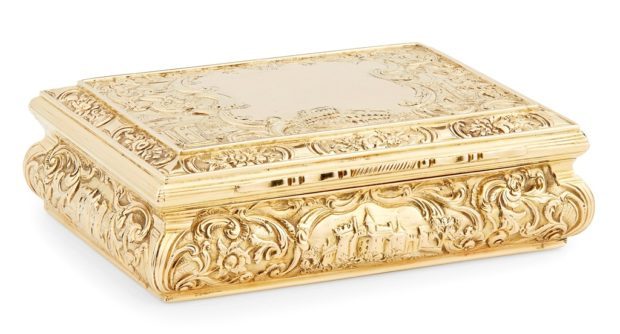Angus Council was rightly cock-a-hoop at the discovery near Carnoustie of a Bronze Age spearhead with a gold socket at the end of its shaft. The weapon is one of only five gold-bound spears to have been found in Britain and Ireland.
Well, Lyon & Turnbull’s auction in Edinburgh on August 15 trumped this by selling a considerable rarity – one of only a quartet of known Scottish gold boxes.
Nineteenth century Scottish gold boxes are extremely rare. Currently as few as four are recorded. One by James Erskine of Aberdeen is in Aberdeen Museum; one by James McKay, engraved with a curling scene, is in an institutional collection; and another by MacKay & Cunningham of the same pattern as the example shown was sold by Sotheby’s last year for £11,250.
The Lyon & Turnbull box was also by James McKay. In 18ct gold, it was made in Edinburgh in 1825 and shows scroll-formed corners and floral panels surrounding a cartouche of a castle and classical buildings.
The interior of the lid is engraved ‘Presented to Robert Steuart Esq of Palmerston by The Members of the East Lothian Club as a mark Gratitude & respect for his service as their secretary 1826.’
The four-inch wide box came from a private family collection and was last sold by Sotheby’s in 1965.
It was hammered down for a mid-estimate £9000.
Incidentally, a Bronze Age dagger with a gold hilt band is an unsung but rare exhibit at Perth Museum. Dating somewhere between 2100BC and 1950BC, it was found in a burial at Forteviot. Its decoration is one of the earliest uses of gold in Scotland.










